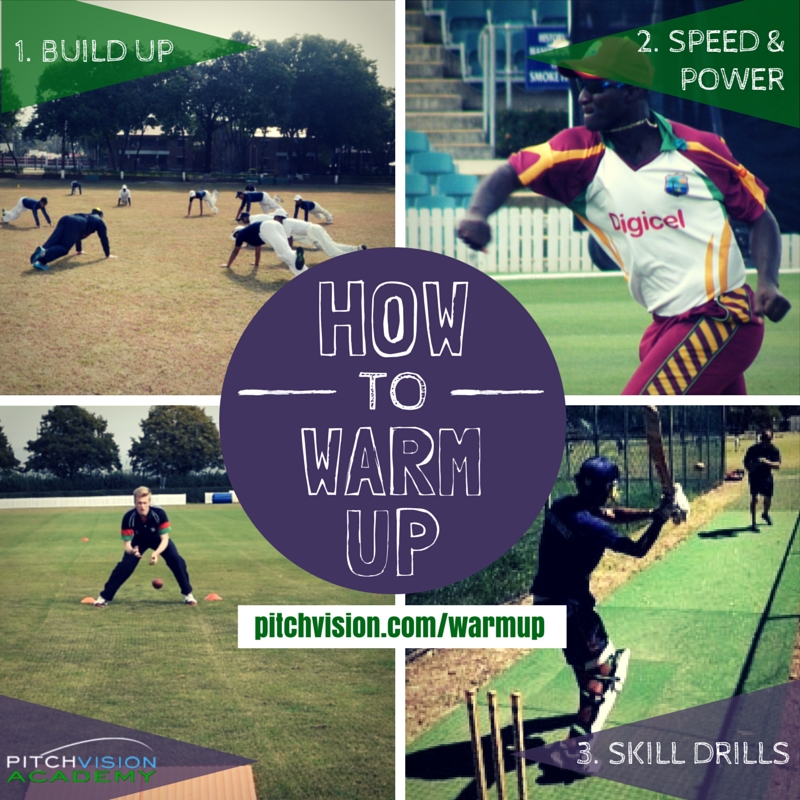How to Warm Up for Cricket
By now we know that cricket warm ups are a great way to prepare your body for play and reduce the chance of injury.
They can also be used to improve your cricket.
Mobility, posture and flexibility are key components in cricket fitness. Often they ignored by cricketers: They are not as useful as technique and not as hardcore as endurance or strength training.
The warm up bridges this gap between cricket performance and normal life. Think of your warm up as a ramp to the top of your game: Without it you will struggle to to get to the top.
Here is the complete cricket warm up to get you to there.
Cricket warm up basics
The idea is to activate all of your cricket playing muscles with slowly increasing intensity. This has the added secondary ability of getting you mentally ready too. Start slow and build up.
NOTE: Warming up is established before games. This is a great idea if you are an opening bowler or batsman, less so if you are in the field and useful only for injury prevention reasons if you bat down the order. Make sure you time your warm up with when you are performing for maximum effect.
For now, we will focus on the pre-match warm up as this is most used. You will need:
- Space to move around: 20 yards square is big enough.
- Time to get physically and mentally ready: 5 minutes is the bare minimum but when you include skill work this can jump up as high as 45 minutes.
- Equipment: This can vary from a couple of cricket balls and a stump up to medicine balls, resistance bands and other expensive gear. Use what you can get.
You can mix and match any of the parts of the warm up depending on time.

1. Starting slow, building up
A lot of teams start with a jog round the outfield, or game of touch rugby or football to raise the pulse rate. This is fine, but can go wrong.
It's better to combine this general pulse raising time with movements that mobilise your cricket playing joints too.
- Walk backwards and forwards, do movements like lunges, side lunges, and hurdle walks at a slow pace.
- Use movements like squats and star jumps as your heart rate moves up.
- Move onto core stability exercises next. Focus on technique rather than exhaustion.
- Change from walking to jogging and perform runner-style movement drills like knee lifts, carioca and skips.
- Finish this section with some simple power movements like standing long jumps, power push ups or med ball throws.
With all these exercises the variables will depend on the individual. Balance the feeling of being ready with doing too much. A very fit player might be happy to do 3 sets of 10 clap push ups where a young or unfit player can't even do a normal press up. Judge your level based on feeling.
You can customise this section to the injury-prevention needs of the team or yourself here. For example, if hamstring pulls are an issue, spend more time on hip mobility exercises. There are loads of movements you can find online.
Overall, you should be working up a sweat but not exhausting yourself.
2. Sprints to focus the mind
A few short sprints really wake you up mentally and physically for cricket. If you have time and the appropriate fitness level, finish with five sprints over 20 yards:
- Sprint 1: Standing Start
- Sprint 2: Sideways Start
- Sprint 3: Backwards Start
- Sprint 4: Lying Start
- Sprint 5: Walking Start
jog back for recovery. You can involve a ball and jump straight to high intensity fielding drills instead.
3. Cricket skills in the warm up
By this point you should be warm enough to perform some cricket fielding, throwing and catching drills at a good intensity. This section is all about "blowing away the cobwebs". That means reminding yourself about skills and getting your eye in close to game time. It's not about technical changes or doing so much your tire yourself out. Find the balance.
Specialists can work on their own skills.
- Batsmen can have a net or do batting drills.
- Bowlers can mark out their run and try hitting a target without a batsman as a distraction.
- Wicketkeepers can either work with the bowlers or find someone to throw them balls.
For more details on this section, have a look at this video we made on the structure of a warm up.
Customise to your cricket needs
The take away point here is that warm ups are simple but they have a lot of options. You need to customise.
There is no one right way to warm up for cricket because every team and player have different needs. That means all the above are general principles in which you can customise based on time, equipment, player needs, player age and skill level.
Perhaps you feel less of number one and more of number three is best for you. That's fine, as long as it gets you in the right frame of mind and prevents injury.
I encourage you to build your own template for a warm up, then spend time finding the mobility drills, skill drills and equipment to perfect your own warm up. It takes a little time, but it's a vital part of success for cricketers set on a long career.
If you are further interested in both warm up and fitness, buy Strength and Conditioning for Cricket here on PitchVision Academy.
- Login to post comments

